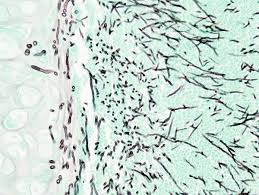Aspergillosis:

The blue rock pigeon — also known as Columba livia — has found itself at the center of a growing controversy due to presumed aspergillosis disease carriers.
- It is an infection caused by Aspergillus — a genus of mold that includes hundreds of species.
- The most common culprit in infections is Aspergillus fumigatus, a fungus that produces tiny airborne spores.
- These spores, when inhaled in large quantities, can cause respiratory illness, especially in individuals with weakened immune systems, preexisting lung conditions, or prolonged exposure to dusty, moldy environments.
- Aspergillus is ubiquitous and found in soil, decaying vegetation, compost, dust, old building materials, air-conditioning systems, bird droppings, and even in grain and spices.
- It thrives in damp and poorly ventilated areas.
- It is not contagious it will not spread from person to person.
- It causes different types of infections with some differences in symptoms.
- Cough and shortness of breath are common symptoms among all types of aspergillosis. Some types of infections cause nasal congestion, headache, fatigue, and coughing up blood.
- Treatment depends on the type of infection and includes antifungal medications like voriconazole or itraconazole.




